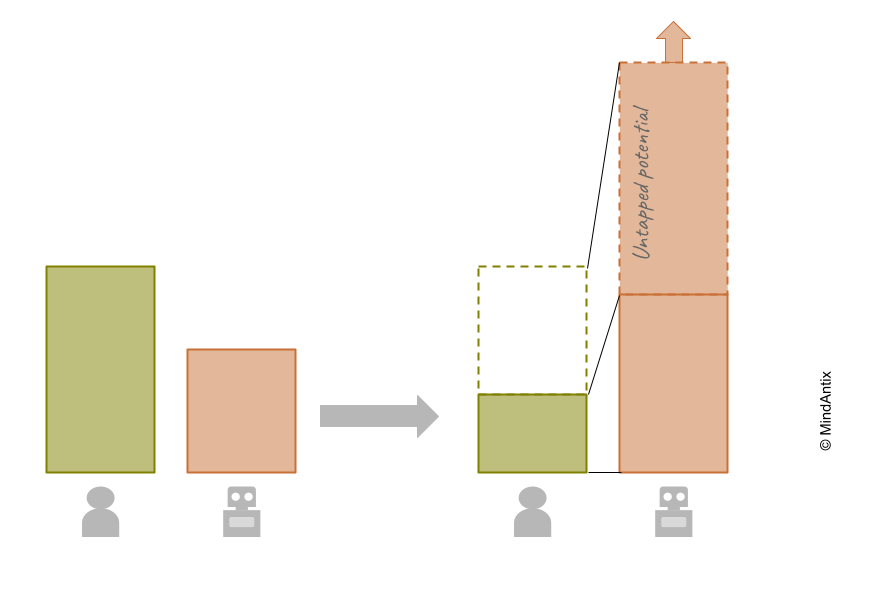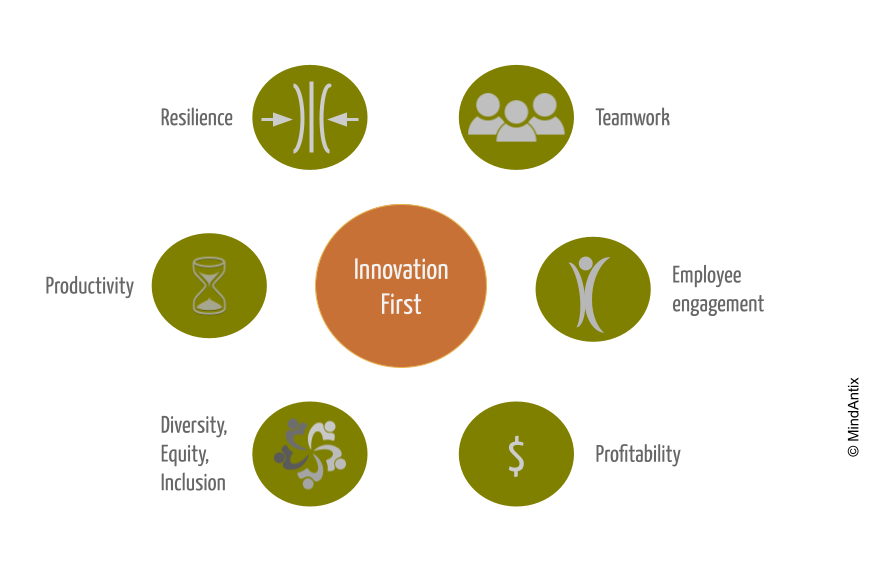The rapid proliferation of Artificial Intelligence (AI) tools like ChatGPT have created both awe and anxiety among people, and led to intense debates about the future of humanity. How should people prepare for a world where AI has a significant presence? What does the future of work look like?
Business leaders have an equally enormous task ahead of them. What are the threats and opportunities posed by AI? What changes do they need to make to their strategy, operations or culture in order to stay relevant? And how does one handle this radical transformation of work while keeping employees engaged?
One estimate says that AI will unlock $15.7 trillion in productivity gains by 2030. However, companies have to take deliberate steps to adapt their organizations in order to capitalize on the potential that AI offers.
With Productivity Commodified, Creativity Becomes More Salient
AI is enabling productivity gains that are orders of magnitude higher than what humans can accomplish. AI can spit out code snippets or new graphics in a matter of seconds, compared to hours it takes a person.
Competing with AI on skills where it can outperform people is pointless. Any business that doesn’t adopt AI productivity and employs people to do the same tasks, will soon fail. Instead, the most promising approach is to harmoniously coexist with AI where people focus on tasks that are uniquely human, like creativity, while AI handles more routine tasks.
Focusing on innovation is important from a differentiation perspective too. When everyone uses AI to help improve their productivity, productivity becomes commodified. The only way then, to stand out among your peers is by using creativity – finding new ways to use the latest technology or creating new capabilities that delight customers. As an example, the low-code/no-code platforms are allowing people from different industries, including health and finance, to create their own applications and improve their workflows.
Creativity is where humans have a distinct advantage. AI hasn’t performed well when it comes to creative tasks because creativity, by definition, requires production of ideas that don’t exist before. Even though AI is transforming the creative industry, the nature of its output is only superficially creative. Current set of AI tools are only good at rearranging existing elements in different ways to give an illusion of creativity. When prompted to create something that is truly original, tools like ChatGPT tend to fail.
Leaders need to recognize that human creativity is now the differentiator for their business and they need to invest heavily in fostering internal innovation.
Laying Off People Is The Wrong Strategy
Staying ahead of the AI acceleration requires proactively redesigning the boundary between human and AI work. This is a continually shifting line and businesses have to be agile when it comes to rearranging work for maximum productivity and innovation.
As a business leader, it might be tempting to think that with AI taking over more and more tasks, your company needs fewer people to do the work that was being done before. This mindset can be dangerous for a company’s competitive advantage because it does not tap into the productivity gains that any new disruptive technology like AI unleashes. Barring a few domains (like some service industries), for any industry that has scalability potential and demands continuous innovation, reducing overall headcount will slow progress and almost certainly backfire in the long run.
To see why this approach is damaging in the long run, let’s assume that your work requires some level of innovation to stay competitive in your market and therefore needs humans-in-the-loop. As more work starts shifting towards AI, it seems reasonable to reduce headcount in order to retain the same level of productivity for a much smaller cost.
However, after a certain level of reduction, people become the critical resource in an organization. Even assuming that people are only doing tasks related to creativity that AI doesn’t handle well, the organization becomes limited by the level of innovation it can harness from its employee base. As the AI capability expands even more (at a much faster rate than people upskilling), the extra capacity remains untapped due to limited people resources. After a short-term boost in productivity and lower costs, organizations get hamstrung in their ability to produce outsized innovations that can put them ahead of their competitors.
Instead of simply reducing headcount to maintain the current levels of productivity, leaders need to take a long-term approach to talent management. Retaining and hiring people with the right skill set for innovation will help organizations take advantage of growing AI capabilities and provide higher levels of productivity and innovation compared to their peers.
Engineering A High Performance Culture
A natural consequence of the increased productivity offered by AI, is that it allows more complex work to be possible. Complex work is high on both innovation and productivity, and the more complex the work, the more you need to tap into the intelligence and expertise of others. However, handling complexity, when humans are a critical part of the loop, is tricky. Groups can behave as intelligent swarms but they can also arrive at incredibly poor outcomes. How smartly a group behaves depends on the overall ability of individuals in the group as well as how independently they are allowed to think. Relatively smart people when thinking without the influence of others, cancel out each other’s errors and biases leading to much better decision making and problem solving that wouldn’t be possible at an individual level.
The single most important thing that organizations can do, in addition to hiring good talent, is to set up processes, tools and norms that allow people to contribute ideas and participate in decision making in independent ways. Without the right performance-focused culture, organizations will find it hard to capitalize on the higher complexity demands.
Leadership Takeaways
Any transformative technology, by its very definition, radically changes the way people do things and opens up new markets and opportunities. How companies respond to the new environment determines how well they can capitalize new opportunities.
Compared to disruptive technologies of the past, AI places new challenges due to the rapid pace of development. Companies need an agile approach to managing people and work.
- Innovation Management is key: With high productivity gains that benefit everyone, It’s inevitable that people-work will shift towards creativity. How well companies harness employee innovation will determine how they differentiate in the market and tap into the value that AI provides.
- Hire for the long-term: Automation eliminates some jobs but typically creates many more new ones. A Deloitte study found that automation in the UK created over 4x more jobs than it eliminated that on average paid more. Instead of laying off people in order to boost short-term efficiency metrics, companies should focus on retaining and retraining employees to handle the higher workloads that are bound to come.
- Build a culture of performance: With AI taking over time-consuming tasks, more complex work that involves higher innovation and productivity will now be possible. Complex problem solving relies on individuals with different expertise to work together towards a common goal. Leaders will need to create a high-performance culture that incentivizes both individual expertise and swarm intelligence.



